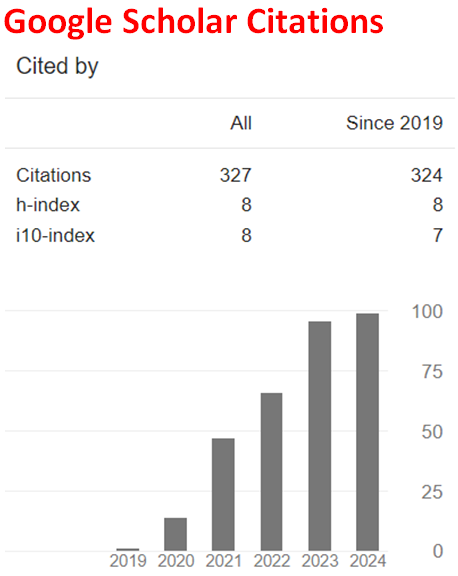Some Novichok agents and their interactions with Zn+2 ion. A DFT study
Abstract
The Novichok agents attracted attention, especially in the Soviet Union in order to synthesize very effective warfare chemicals. They belong to the class of organophosphate acetyl cholinesterase inhibitors. In the present study, of those agents A-230, A-232, A‑234, A-242 and A-262 have been considered within the restrictions of density functional theory at the level of B3LYP/6-31++G(d,p). Also the Zn+2 composites of those agents have been considered. All the structures are electronically stable, thermodynamically exothermic and have favorable Gibbs’ free energy of formation values at the standard states. Various quantum chemical properties of them, including UV-VIS spectra, the HOMO and LUMO energies etc., have been obtained and discussed.
References
Nepovimova, E., & Kuca, K. (2018). Chemical warfare agent NOVICHOK - mini- review of available data. Food and Chemical Toxicology, 121, 343-350. https://doi.org/10.1016/j.fct.2018.09.015
Halámek, E., & Kobliha, Z. (2011). Potential chemical warfare agents. Chem. Listy, 105, 5, 323-333. http://blog.chemicke-listy.cz/ojs3/index.php/chemicke-listy/article/view/1136
Szinicz, L. (2005). History of chemical and biological warfare agents. Toxicology, 214, 167-181. https://doi.org/10.1016/j.tox.2005.06.011
Coleman, K. (2005). A history of chemical warfare. London: Palgrave Macmillan UK, https://doi.org/10.1057/9780230501836
Ledgard, J. (2006). A laboratory history of chemical warfare agents. Jared Ledgard.
Pitschmann, V. (2014). Overall view of chemical and biochemical weapons. Toxins, 6, 1761-1784. https://doi.org/10.3390/toxins6061761
Tucker, J.B. (2006). War of nerves: chemical warfare from World War I to Alqaeda. NY: Pantheon Books. https://hdl.loc.gov/loc.gdc/gdcwebcasts.060308tucker
Wiener, S.W., & Hoffman, R.S. (2004). Nerve agents: a comprehensive review. J. Intensive Care Med., 19, 22-37. https://doi.org/10.1177/0885066603258659
Romano, J.A., Salem, H., Lukey, B.J., & Lukey, B.J. (2007). Chemical warfare agents: chemistry, pharmacology, toxicology, and therapeutics (2nd ed.). NY: CRC Press.
Chai, P.R., Hayes, B.D., Erickson, T.B., &. Boyer, E.W. (2018). Novichok agents: a historical, current, and toxicological perspective. Toxicology Communications, 2(1), 45- 48. https://doi.org/10.1080/24734306.2018.1475151
Ellison, D.H. (2008). Handbook of chemical and biological warfare agents (2nd ed.). Boca Raton, FL: Taylor and Francis Group.
Halámek, E. (2008). Poslední generace chemických zbraní. Czech Mil. Rev., 137-146.
Kruglyak, Y.L., Malekin, S.I., Leibovskaya, G.A., Khromova, Z.I., Sretenskaya, I.I., & Martynov, I.V. (1972). Reaction of a-chloronitrosoalkanes with phospholanes and iminophosphites. In: Khim. Primen. Fosfororg. Soedin. 1969. Presented at the Khim. Primen. Fosfororg. Soedin. 1969, Nauka, Moscow, USSR, pp. 307-312.
Kruglyak, Y.L., Malekin, S.I., & Martynov, I.V. (1972). Phosphorylated oximes. XII. Reactions of 2-halophospholanes with dichlorofluoronitrosomethane. Russ. J. Gen. Chem., 42, 811-814.
Malekin, S.I., Yakutin, V.I., Sokaĺskii, M.A., Kruglyak, Y.L., & Martynov, I.V. (1972). Mechanism of the reaction of alpha-chloronitrosoalkanes with phosphorus(III) compounds. Russ. J. Gen. Chem., 42, 807-811.
Martynov, I.V., Kruglyak, Y.L., & Malekin, S.I. (1969). Carbonyl Halide Oxime B-chloroalkyl Fluorophosphates. SU 241433 19690418.
Petrov, A.A., Razumova, N.A., & Evtikhov, Z.L. (1967). Condensation of acid fluorides of glycol phosphites with diene hydrocarbons. Russ. J. Gen. Chem., 37, 1410-1411.
Razumova, N.A., Evtikhov, Z.L., & Petrov, A.A., 1968. Phosphorus-containing heterocycles. XV. Acid fluorides of glycolphosphorous acids. Russ. J. Gen. Chem., 38, 1117-1122.
Mirzayanov, V.S. (2009). State secrets: an insider’s chronicle of the Russian chemical weapons program. Outskirts Press, Incorporated. ISBN 1432719238, 9781432719234
Sajid, H., Khan, S., Ayub, K., & Mahmood, T. (2021). Effective adsorption of A-series chemical warfare agents on graphdiyne nanoflake: a DFT study. Journal of Molecular Modeling, 27, 117. https://doi.org/10.1007/s00894-021-04730-3
Zhang, T., Sun, H., Wang, F., Zhang, W., Tang, S., Ma, J., Gong, H., & Zhang, J. (2017). Adsorption of phosgene molecule on the transition metal-doped graphene: first principles calculations. Appl. Surf. Sci., 425, 340-350. https://doi.org/10.1016/j.apsusc.2017.06.229
Chauhan, S., Chauhan, S., D’Cruz R., Faruqi, S., Singh, K.K., Varma, S., Singh, M., & Karthik, V. (2008). Chemical warfare agents. Environ. Toxicol. Pharmacol., 26, 113-122. https://doi.org/10.1016/j.etap.2008.03.003
Vieira, L.A., Almeida, J.S.F.D., França, T.C.C., & Borges, I., Jr. (2021). Electronic and spectroscopic properties of A-series nerve agents. Computational and Theoretical Chemistry, 1202, 113321. https://doi.org/10.1016/j.comptc.2021.113321
Bhakhoa, H., Rhyman, L., & Ramasami, P. (2019). Theoretical study of the molecular aspect of the suspected novichok agent A234 of the Skripal poisoning. R. Soc. Open Sci., 6. https://doi.org/10.1098/rsos.181831
Jeong, K., & Choi, J. (2019). Theoretical study on the toxicity of ‘Novichok’ agent candidates. R. Soc. Open Sci., 6, 1-6. https://doi.org/10.1098/rsos.190414
Stewart, J.J.P. (1989). Optimization of parameters for semi-empirical methods I. J. Comput. Chem., 10, 209-220. https://doi.org/10.1002/jcc.540100208
Stewart, J.J.P. (1989). Optimization of parameters for semi-empirical methods II. J. Comput. Chem., 10, 221-264. https://doi.org/10.1002/jcc.540100209
Leach, A.R. (1997). Molecular modeling. Essex: Longman.
Kohn, W., & Sham, L.J. (1965). Self-consistent equations including exchange and correlation effects. Phys. Rev., 140, 1133-1138. https://doi.org/10.1103/PhysRev.140.A1133
Parr, R.G., & Yang, W. (1989). Density functional theory of atoms and molecules. London: Oxford University Press.
Becke, A.D. (1988). Density-functional exchange-energy approximation with correct asymptotic behavior. Phys. Rev. A, 38, 3098-3100. https://doi.org/10.1103/PhysRevA.38.3098
Vosko, S.H., Wilk, L., & Nusair, M. (1980). Accurate spin-dependent electron liquid correlation energies for local spin density calculations: a critical analysis. Can. J. Phys., 58, 1200-1211. https://doi.org/10.1139/p80-159
Lee, C., Yang, W., & Parr, R.G. (1988). Development of the Colle-Salvetti correlation energy formula into a functional of the electron density. Phys. Rev. B, 37, 785-789. https://doi.org/10.1103/PhysRevB.37.785
SPARTAN 06 (2006). Wavefunction Inc. Irvine CA, USA.
SPARTAN (2005). Molecular modelling in physical chemistry. Irvine CA, USA: Wavefunction Inc.
Durant, P.J., & Durant, B. (1972). Introduction to advanced inorganic chemistry. London: Longman.
Maret, W., & Sandstead, H.H. (2006). Zinc requirements and the risks and benefits of zinc supplementation. Journal of Trace Elements in Medicine and Biology, 20(1), 3-18, https://doi.org/10.1016/j.jtemb.2006.01.006
Graham, J., & Odent, M. (1986). The Z-factor, Rochester, Vermont: Thorsons Pub.
Lonnerdal, B., Keen, C., & Hurley, L.B. (1984). Zinc binding ligands and complexes in, zinc metabolism. Adv. Nutr. Res., 6, 139-167. https://doi.org/10.1007/978-1-4613-2801-8_6
Dewar, J.M.S. (1969). The molecular orbital theory of organic chemistry. New York: McGraw-Hill.
Fleming, I. (1976). Frontier orbitals and organic reactions. London: Wiley.

This work is licensed under a Creative Commons Attribution 4.0 International License.


